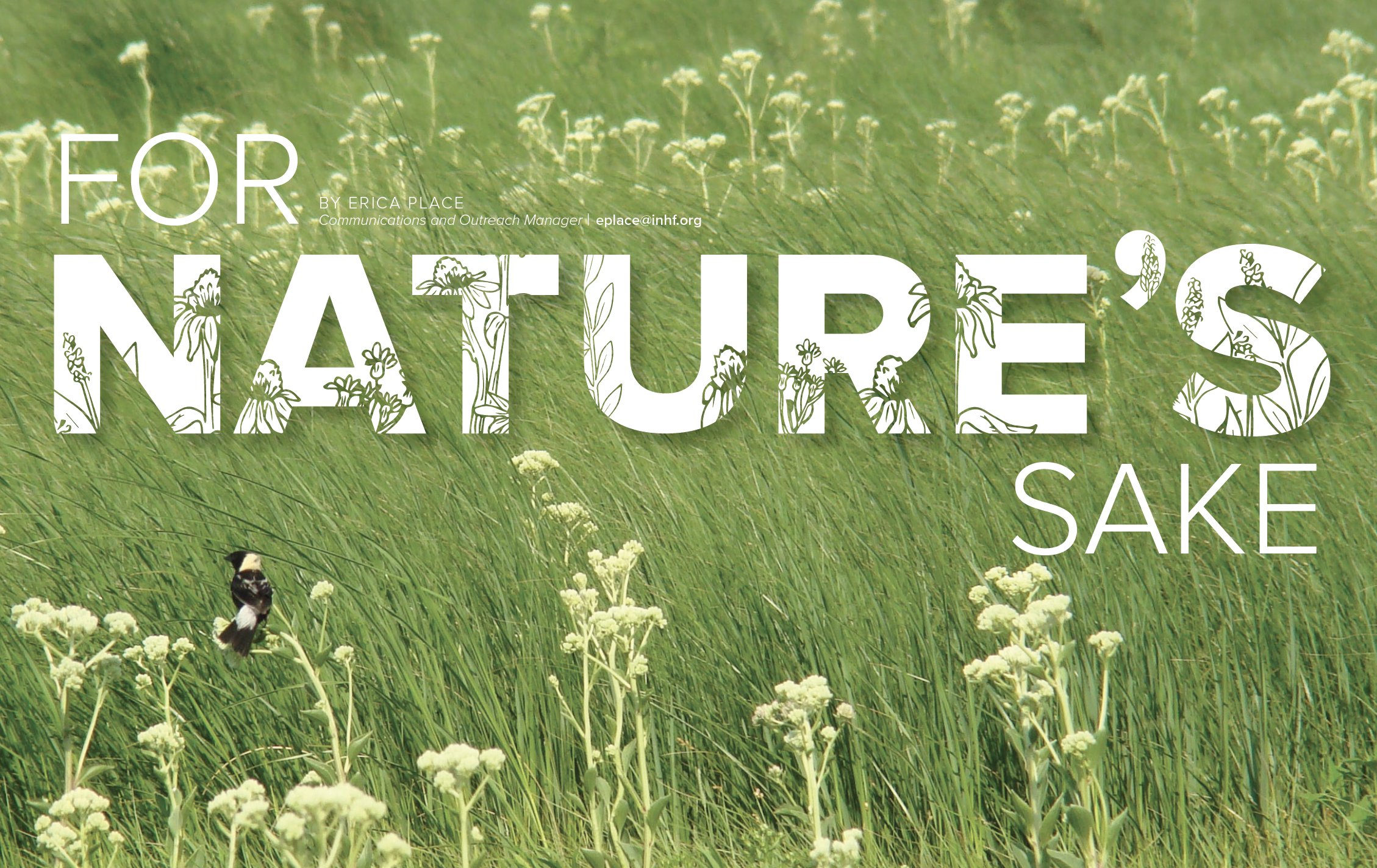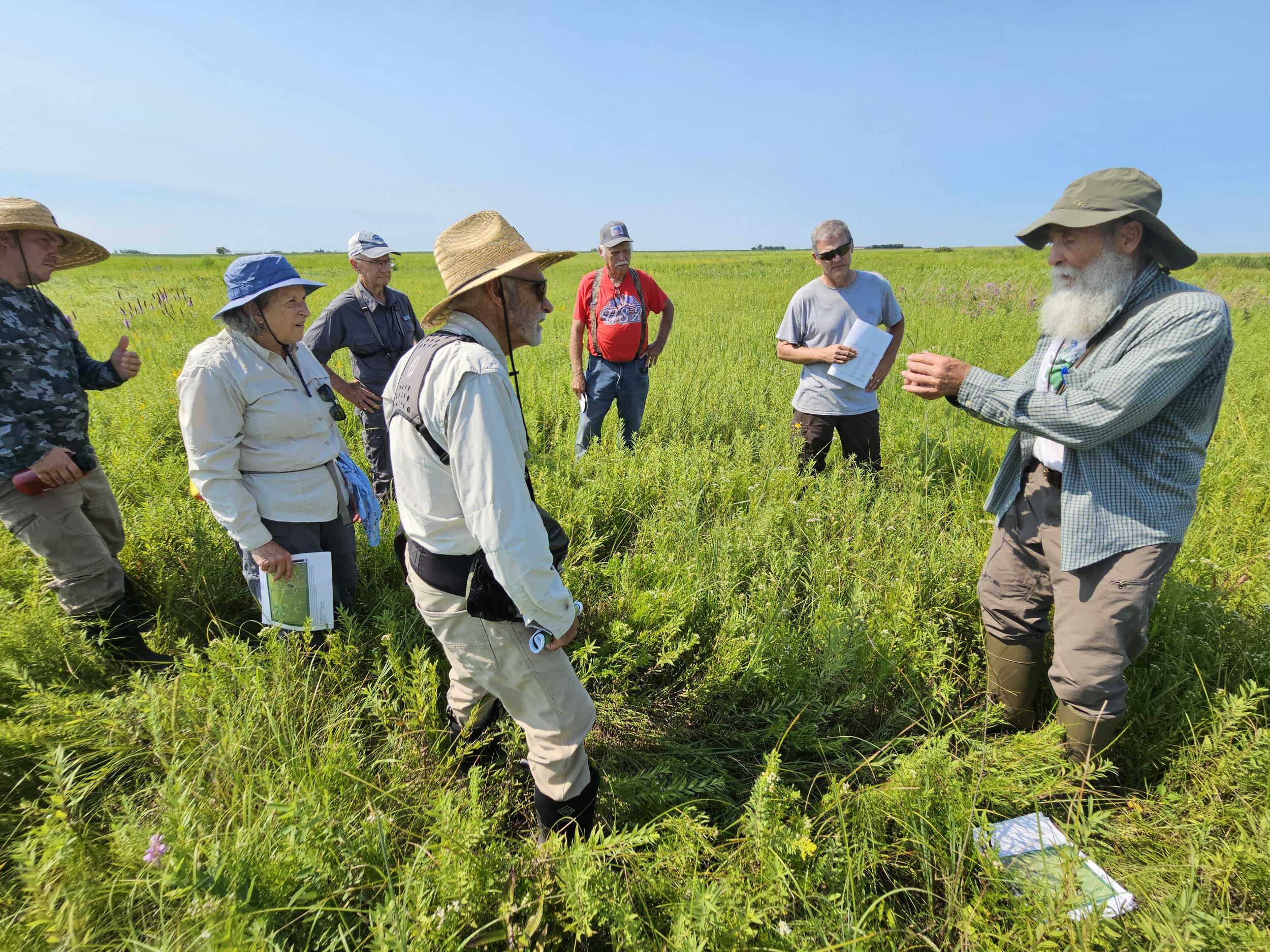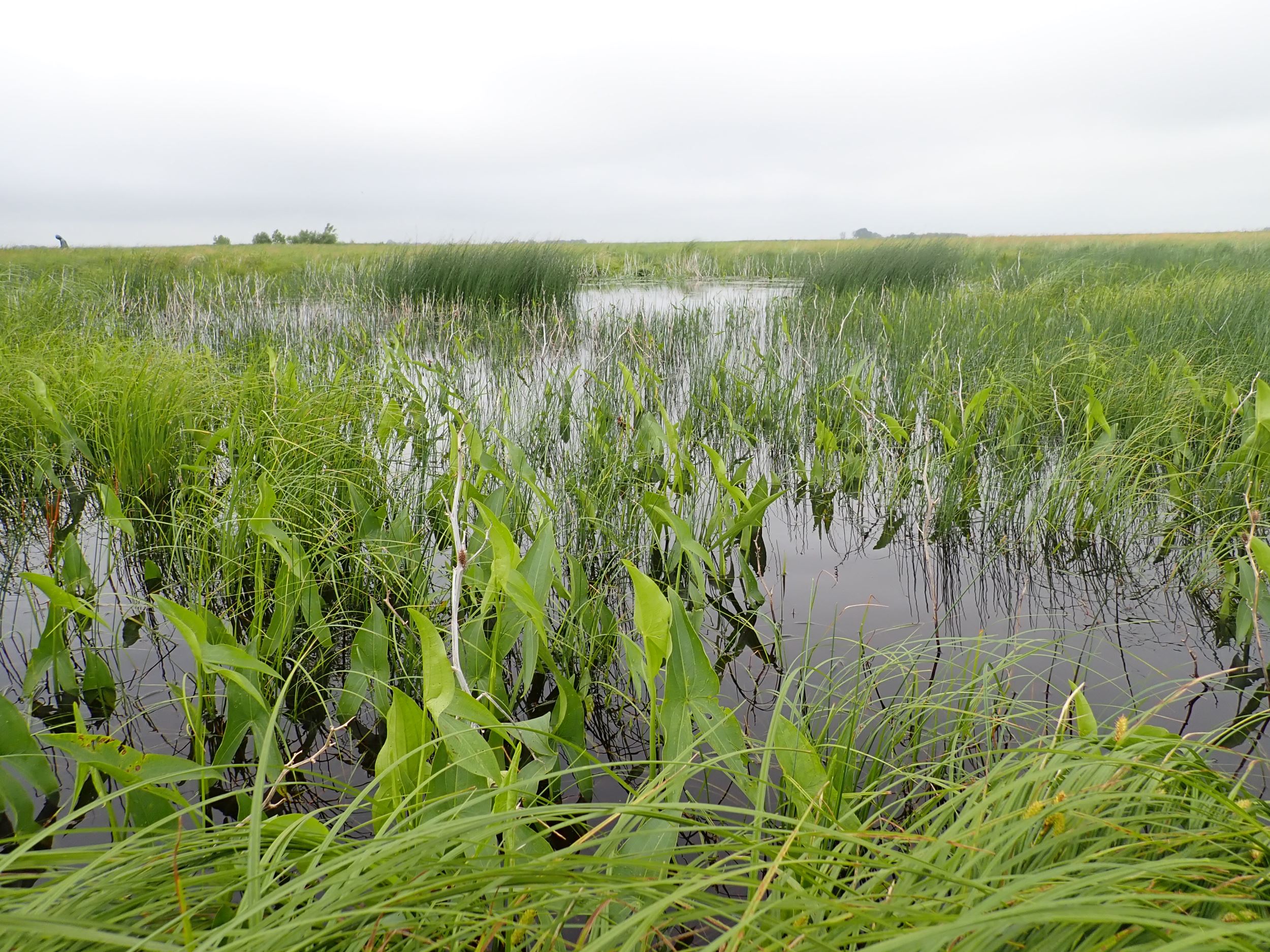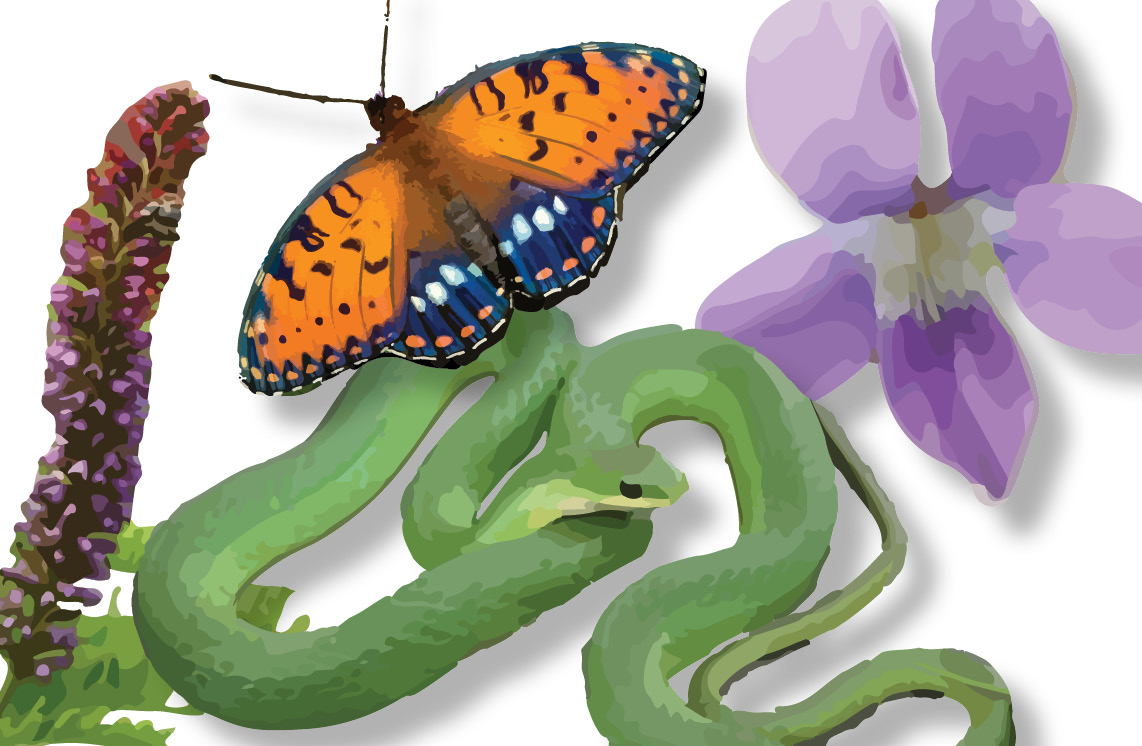For Nature's Stake
By Erica Place on May 20, 2025 in Blog

It was an early morning trip to Kossuth County for INHF president Joe McGovern, a drive he’d made many times during his tenure at the organization. He was headed to a property near Algona — Wildin Heritage Prairie — to lead a hike alongside Dr. Thomas Rosburg, an ecology and botany professor at Drake University. Dr. Rosburg had just concluded a second floristic inventory at the 80-acre remnant sedge meadow prairie, and it was the perfect time of year to share those results and showcase the prairie’s beauty in the height of bloom season.
The new inventory had revealed an impressive 147 native plant species, all making their home in this lush patch of prairie surrounded by farmland. Joe thought back to what this prairie looked like on his first visit when he was INHF’s land stewardship director.
He and coworker Bruce Mountain, INHF’s land projects director at the time, had driven here more than two decades earlier. A local estate attorney, Thomas Lipps, indicated his client was hoping to sell a property to a conservation-minded buyer and wondered if INHF might like to see it. It had never been plowed, never been drained and never been widely treated with herbicides. But standing there, it wasn’t immediately obvious to Joe or Bruce what plants remained. It had a long history of haying and grazing — both relatively low-impact land uses, but enough to disguise its potential. Purchasing it would be a risky gamble for a younger organization with limited resources.
If it weren’t for a conversation he’d had just a couple days prior with landowners at Indiangrass Hills, a 640-acre grassland property being restored in Iowa County, Joe might not have pushed for the purchase of Wildin Heritage Prairie. But he’d heard from these landowners that they were seeing great success in letting their land rest after many years of intense grazing. Under the careful stewardship of Judy Felder, Mary Brown, Sandy Rhodes, and Bill and Barby Buss, species at Indiangrass Hills were coming back — lots of species — even though the vegetation had previously been chomped down as short as astroturf. It was a commonly held belief that land in that state was a lost cause: nothing could possibly come back. That whatever prairie had been there was lost forever. But these landowners had proof it was possible, and Joe had seen it, not three days before stepping foot on this potential purchase.
“We have to give it a try,” Joe thought. “Every bit of remnant prairie is worth the risk.”
Joe’s freshly gained perspective and insistent curiosity, coupled with the board’s culture of trying, was what ultimately nudged INHF into taking the risk. INHF purchased Wildin Heritage Prairie in 2002.
And the plants did come back. Dr. Rosburg’s initial floristic inventory in 2003 (just a year after it was purchased) documented 125 native plant species, including more than a dozen species that indicate a high-quality site. It was a really good buy.
 Today’s hike participants had been promised good views of small prairie potholes, unique plant communities and opportunities to see wildlife before the sun got high enough to remind everyone it was the peak of summer. Anxious to do a preliminary walk through and practice his talking points, Joe pulled up to the prairie well before the advertised start time. But an old farm truck was already backed into the field entrance — someone had beaten him there.
Today’s hike participants had been promised good views of small prairie potholes, unique plant communities and opportunities to see wildlife before the sun got high enough to remind everyone it was the peak of summer. Anxious to do a preliminary walk through and practice his talking points, Joe pulled up to the prairie well before the advertised start time. But an old farm truck was already backed into the field entrance — someone had beaten him there.
It was Dave Wildin.
Dave had grown up in Algona, helping his dad, George, and siblings cut and bale hay on what is now known as Wildin Heritage Prairie. The “wild hay” had to be harvested in patchy swaths to avoid the more than dozen wet depressions throughout the property — remnant prairie potholes. Dave and his siblings urged their dad more than once to consider tiling the land to make these chores easier. It could be more profitable in row crops, anyway. But George wouldn’t have it. The Wildin family cropped other land, but this hay and pasture ground was too important for their cow-calf operation.
Safely home from a distressing time as a recent high school graduate drafted into the army and stationed in Santo Domingo during the Vietnam War, Dave pursued many interests and business ventures. He earned degrees in Math and Industrial Technology from the University of Northern Iowa, substitute taught at a high school in Mason City, started a powersports company and farmed in between. The prairie his dad wouldn’t allow to be plowed remained through it all, though, all the way up to George’s passing in 2002. Dave and his siblings were faced with a decision — keep the land or cash in. While the other siblings were eager to sell, Dave saw the land as an investment. His grandfather, who had immigrated from England and moved to Eagle Grove in the 1920s, had amassed more than 1,000 acres of farmland for the family. Dave tried his best to convince his siblings to keep this piece — but to no avail.
“I told them that if this is what they were sure they wanted, then they needed to let me handle it,” Dave remembers. “I’ll find someone who wants to buy it.”
Even though the land, which was flat and on some of Iowa’s best soil, could have fetched more money being sold for conventional ag, Dave knew he had to find someone willing to honor his dad’s legacy. He had to find a buyer who wouldn’t plow or drain it.
It was Dave’s attorney who had connected with INHF all those years ago. It was Dave who had saved this gem, where a prairie hike was about to take place.
While events had been held at Wildin Heritage Prairie in the years since the sale, this was the first Dave had heard about. Amy Frankl Brandt, who was helping Dave edit a memoir he’d written recounting his time in Santo Domingo, also worked for the Algona Publishing Company and had received a press release inviting locals to attend a hike at Wildin Heritage Prairie. Recognizing the name, she forwarded it to Dave who was curious to see what this was all about.
“I really didn’t know it was this special,” says Dave. “I was amazed anyone’s got so much interest in this that they’d want to come hike around.”
There were certainly people who wanted to see it. Dave spent that August morning following Dr. Rosburg, Joe McGovern, members of the Iowa Prairie Network and others through the prairie as they ooed and awed over their observations.
 “A trip to Wildin Prairie is a journey backward in time, an opportunity to see and feel a landscape that otherwise can only be vaguely imagined,” Dr. Rosburg explains. “Much of the Des Moines Lobe’s 12,000 square miles was graced by the prairie-pothole landscape — Wildin Prairie shows us the northern version of that ecosystem. It shows us how 150 native plant species can coexist and thrive in a mosaic of wet-mesic prairie, sedge meadow and shallow marsh communities. Its natural splendor is overwhelming. The plants you see — and their ancestors — have occupied this land for several thousands of years. They and the animals they support have an absolute right to this place. The Wildin family has given Iowans a gift of immeasurable value. A place where time fades away and Nature is all that matters.”
“A trip to Wildin Prairie is a journey backward in time, an opportunity to see and feel a landscape that otherwise can only be vaguely imagined,” Dr. Rosburg explains. “Much of the Des Moines Lobe’s 12,000 square miles was graced by the prairie-pothole landscape — Wildin Prairie shows us the northern version of that ecosystem. It shows us how 150 native plant species can coexist and thrive in a mosaic of wet-mesic prairie, sedge meadow and shallow marsh communities. Its natural splendor is overwhelming. The plants you see — and their ancestors — have occupied this land for several thousands of years. They and the animals they support have an absolute right to this place. The Wildin family has given Iowans a gift of immeasurable value. A place where time fades away and Nature is all that matters.”
“I learned more about that prairie that morning than I’d known my whole life,” Dave remarks.
More than twenty years later, Dave is even more confident in his choice to sell his father’s beloved land to a conservation buyer.
“It really reinforced my decision,” says Dave. “It made me feel good that it amounted to something; I didn’t really realize what I’d done at the time. If anybody else has an opportunity to do something like this… what a legacy it can be. A legacy for the whole country.”

Indigo bush, regal fritillary, smooth green snake, and prairie violet are all found at Wildin Heritage Prairie and are relatively uncommon.
Wildin Heritage Prairie will forever remain as a wild space. Outside of scheduled events, it doesn’t offer outdoor recreation opportunities. These 80 acres might not make a significant economic impact on neighboring communities — but can you really put a price on a smooth green snake, Savanna Sparrow or regal fritillary? It’s a legacy for a reason far greater: the inherent value of wild places. This is a story of protecting nature for nature’s sake. A story that might have been lost forever if it weren’t for the family’s conviction, the connection made by the attorney, or the willingness to take a chance.
The hike participants went back to their cars with soggy boots, scribbles in their plant guides and a few bug bites. But none, except for maybe Joe, left with hearts as full as Dave Wildin’s:
“I’m sure this would have pleased my dad to no end.”